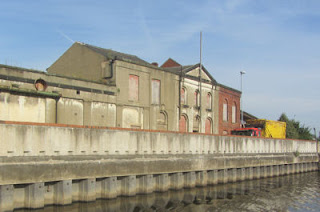Wakefield, like many of the waterside cities, is undergoing gradual transformation as new developments replace the disused industrial sites. This view combines some of the slightly older buildings, one in the distance with pictures of the plans for its renewal and, immediately opposite our overnight mooring, a new pub.
 |
| Wakefield Flood Gates |
Just after joining the river we passed this building, now looking rather unloved but was at one time obviously rather grand, especially in an industrial area.
At the first lock we had to take out our piece of timber that makes-do as a Calder and Hebble handspike. Sadly, most of the paddles of this type we encountered today were rather heavy to work, even those which have recently been re-constructed.
At the end of a straight cut is the flood lock.
Broad Cut Low Lock has unusual top ground paddles which discharge at a level about the boat when first coming up - a trap for the unwary as normally ground paddles should be opened before gate paddles.
At one time this section of the navigation was lined by collieries on both sides, with the occasional power station thrown in. Much of the coal to generate electricity was carried by barge from the nearby pits. When the railways arrived, many special purpose lines were built to serve new pits and the bridges over the canal are sometimes the only clear evidence of this former activity. Most of the river and canal is now lined with trees and looks rural - even where there is still some industrial activity it is well hidden from the waterside.
This picture is really so that we can recount the special claim to fame of the church in Horbury. (We hope that this is the correct church as the OS map shows three spires in the town centre!) Onward Christian Soldiers was written by Sabine Baring-Gould as a marching hymn for the children of Horbury Bridge where he was a curate. Initially the music was based on an extract from a Haydn symphony but was not especially popular until Arthur Sullivan set it to the tune well-know today. Baring-Gould claims to have written the hymn in 15 minutes! This is why he was willing to allow later hymnbook compilers to 'improve' the words.
 |
| Figure of Three Upper Lock |
 |
| Former Lock Cut to River |
Some of the bridges look especially striking against a clear blue sky.
 |
| Start of Dewsbury Arm |
 |
| Approaching the end of the arm |
At one time this wharf served a large power station at Thornhill but this is all that remains. Just around the corner is a new gas fired power station, much smaller in physical size.
Nearby, a gang were climbing a pylon and welcomed us as we passed by.
 |
| Shepley Lock |
 |
| Mirfield (visitor moorings just under bridge) |
Railway arches going nowhere.
Waiting for Battyeford Lock.
There were good, empty, moorings just before Cooper Bridge Flood Gates so we pulled ion for the night. We managed to get far enough away from the main Leeds Road bridge to avoid most of the traffic noise. Christine spotted that there is a Spar shop nearby for a paper in the morning!
14.0 miles - 15 locks

















No comments:
Post a Comment